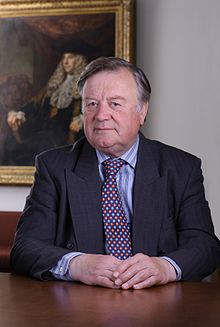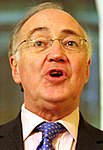1997 Conservative Party leadership election
| |||||||||||||||||||||||||||||||||||||||||||||||
| |||||||||||||||||||||||||||||||||||||||||||||||
| |||||||||||||||||||||||||||||||||||||||||||||||
A leadership election was triggered in the British Conservative Party when John Major resigned on 2 May 1997, following his party's defeat at the 1997 general election (which ended 18 years of Conservative government of the UK).[1] Major had been Conservative leader and Prime Minister since 1990.[1]
Candidates
Announced

The following candidates announced their intention to stand:
Announced but withdrew
- Stephen Dorrell - withdrew in favour of Clarke before the ballot.[1] Dorrell had the support of 8 or 9 MPs, some of whom did not transfer their support to Clarke due to his pro-European opinions.[2]
Declined Candidates
- Michael Heseltine - had been widely expected to contest the leadership but declined to following health concerns. Heseltine supported Kenneth Clarke during the contest.[3]
Not an MP at the time
In the months before the general election a number of other prominent Conservatives were talked about as potential leaders; however, several failed to hold their seats in the general election including the following:
In addition, many had speculated about Chris Patten returning to Westminster (he had lost his seat in the 1992 election) and becoming leader; however, the contest took place before Patten's term of office as Governor of Hong Kong ended.
Results

| First Ballot: 10 June 1997 | |||
|---|---|---|---|
| Candidate | Votes | % | |
| style="background-color: Template:Conservative Party (UK)/meta/color" | | Kenneth Clarke | 49 | 29.9 |
| style="background-color: Template:Conservative Party (UK)/meta/color" | | William Hague | 41 | 25.0 |
| style="background-color: Template:Conservative Party (UK)/meta/color" | | John Redwood | 27 | 16.5 |
| style="background-color: Template:Conservative Party (UK)/meta/color" | | Peter Lilley | 24 | 14.6 |
| style="background-color: Template:Conservative Party (UK)/meta/color" | | Michael Howard | 23 | 14.0 |
| Turnout | 164 | 100 | |
| Michael Howard eliminated. | |||
Howard had been regarded as a serious contender but had been damaged by the criticisms of Ann Widdecombe (who had served under him at the Home Office) that he had "something of the night about him"[4] and by the decision of William Hague, who had originally agreed to support Howard and become Deputy Leader, to stand in his own right.[1]
Second round
Peter Lilley withdrew. He and Howard gave their backing to William Hague.[1][5]
| Second Ballot: 17 June 1997 | |||
|---|---|---|---|
| Candidate | Votes | % | |
| style="background-color: Template:Conservative Party (UK)/meta/color" | | Kenneth Clarke | 64 | 39.0 |
| style="background-color: Template:Conservative Party (UK)/meta/color" | | William Hague | 62 | 37.8 |
| style="background-color: Template:Conservative Party (UK)/meta/color" | | John Redwood | 38 | 23.2 |
| Turnout | 164 | 100 | |
| John Redwood eliminated | |||
Final Round
For the final round, Redwood gave his backing to Clarke, an unusual development in that Redwood (eurosceptic) and Clarke (europhile) held opposite views on the main issue of dispute amongst Conservatives.[6] In return for the endorsement, it was generally understood that Clarke would name Redwood Shadow Chancellor.[1] This pact backfired, however, and the agreement was seen as so cynical that it drew comparison to the Nazi-Soviet Pact of the late 1930s.[6] It prompted former Conservative Prime Minister Baroness Thatcher to publicly endorse Hague.[6] In the event, most of Redwood's supporters switched to Hague rather than to Clarke.
| Third Ballot: 19 June 1997 | |||
|---|---|---|---|
| Candidate | Votes | % | |
| style="background-color: Template:Conservative Party (UK)/meta/color" | | William Hague | 90 | 55.2 |
| style="background-color: Template:Conservative Party (UK)/meta/color" | | Kenneth Clarke | 72 | 44.2 |
| style="background-color: Template:Conservative Party (UK)/meta/color" | | Abstentions | 1 | 0.6 |
| Turnout | 163 | 99.4 | |
| William Hague elected leader of the Conservative Party | |||
Julian Lewis announced that he was the only MP who did not vote.
Aftermath
Under William Hague's leadership, the party would fail to make any significant advance at the 2001 general election, and he was succeeded by Iain Duncan Smith.
In 1998 the system of leadership elections was altered to the present form, where MPs choose a short-list of two candidates, who are then presented to the mass membership to choose. An incumbent leader can still be ousted by a no-confidence vote of Conservative MPs, as was done to Iain Duncan Smith in 2003. A leader could therefore (in principle) be ousted by MPs despite still enjoying the support of the mass membership.
References
- ^ a b c d e f g h i j k "The 1997 Conservative Leadership Contest". BBC Politics 97. BBC. 1997. Retrieved 19 June 2012.
- ^ "Dorrell Pulls Out of Leadership Race". BBC Politics 97. BBC. 1997. Retrieved 19 June 2012.
- ^ "Kenneth Clarke". BBC Politics 97. BBC. 1997. Retrieved 19 June 2012.
- ^ "Howard Under Attack by Former Minister". BBC Politics 97. BBC. 1997. Retrieved 19 June 2012.
- ^ "Lilley and Howard Quit Leadership Race". BBC Politics 97. BBC. 1997. Retrieved 19 June 2012.
- ^ a b c "John Redwood". BBC Politics 97. BBC. 1997. Retrieved 19 June 2012.







